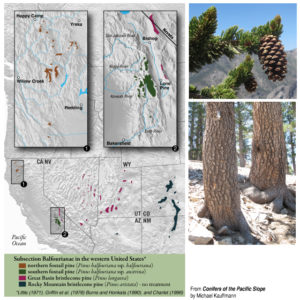Great Basin bristlecone pine
Pinus longaeva
Tree: to 50′ and 12′ DBH; crown irregular or rounded, sometimes krummholz at timberline
Bark: reddish-brown, blocking with shallow furrows
Needles: 1”- 1.5”, 5 per bundle, straight and tightly packed together in dense clusters, dark yellowish-green Seed
Cones: 2.5”- 4”, red to purple-yellow, stout, tapering to a point, sharp prickle at tips of each scale
Habitat: 7,500′-11,500′, highest peaks of Great Basin, including several populations in White and Inyo Mountains of California eastward into Nevada; prefers limey soils (limestone, dolomite, or marble)
Observations: a visit to the Ancient Bristlecone Pine Forest in the Inyo National Forest is an experience of a lifetime—growing somewhere along the Methuselah Trail is one of the oldest living thing on Earth; the Spring Mountains near Las Vegas, NV hold many remarkable stands as well
Remarks: highly tolerant of heat and drought; lifespan nearing 5,000 years; put them on your bucket list!
Information from Conifers of the Pacific Slope by Michael Kauffmann.


